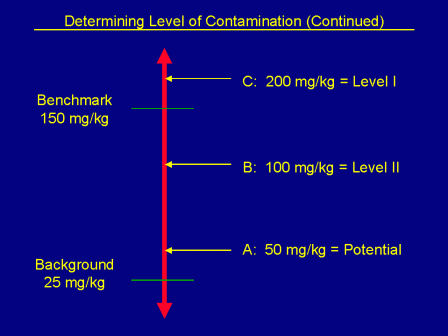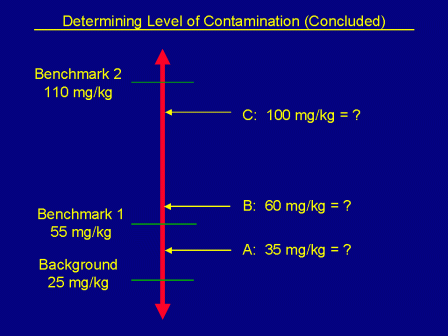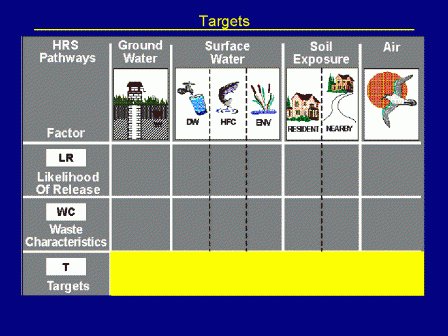Section 7: Targets
The third factor category in the HRS pathway score equation is the targets. Targets are those people, resources, or sensitive environments that could be affected by the site. Targets are the only HRS factor category that has no consistent maximum value. Target factors are evaluated based on the assigned value of each target and its level of contamination. This section will discuss the process for determining the level of contamination of a target.
7.1 Level of Contamination
At any target with hazardous substances present, there can be different levels of contamination. Targets can be subject to either actual or potential contamination. Actual contamination is established when there is an observed release of hazardous substances at a target location. The observed release can be established by either chemical analysis or by direct observation. Actual contamination is further divided into Level I and Level II based on the concentration of hazardous substances at the particular target. All other targets are considered subject to potential contamination.
Distinguishing among levels of contamination is important because it affects the factor values assigned to the nearest individual, sensitive environments, and population factors. It may also affect the waste characteristics factor category through its influence on the minimum factor value assigned for the hazardous waste quantity factor in a migration pathway.
7.2 Actual Contamination
This graphic illustrates a typical case for determining actual contamination in an air pathway. Included in this illustration are the following components:
- Background Station. Sampling location used to determine the background level for substances in observed release evaluations.
- Source. Represents the source of the observed release of the hazardous substance.
- Station A. The sampling location of the air pathway from which an observed release was documented.
- Distance Rings. Represent areas of equal distance from the source.
When an observed release has been demonstrated at Station A, all air pathway targets located in the same distance ring as Station A as well as any targets located in rings closer to the source, are considered to be subject to actual contamination. It is important to note that although the wind direction during sampling is important in determining whether an observed release has occurred, it does not otherwise affect the assessment of actual contamination.
Actual Contamination in the Soil Exposure Pathway
Actual contamination in the soil exposure pathway is unique in several respects. It will be discussed in greater detail in Section 18: Soil Exposure Pathway - Resident Population Threat.
7.3 Determining Level of Contamination
Once targets are determined to be actually contaminated, they are further evaluated to determine whether they are subject to either Level I or Level II concentrations. The HRS does not distinguish between levels of contamination in evaluating air pathway sensitive environment target factors.
Level I concentrations can only be established in those cases where the observed release has been established by chemical analysis. Level I concentrations are established when the concentrations at the observed release sampling location meet or exceed media-specific benchmarks. The HRS specifically defines these benchmarks for each pathway.
Level II concentrations are established whenever actual contamination is present, but Level I concentration requirements have not been met, i.e.:
- targets are subject to actual contamination established by direct observations, or
- targets are subject to actual contamination established by chemical analysis but the concentrations at the observed release sampling locations(s) are less than all of the applicable, media-specific benchmarks.
The HRS lists the nine types of media-specific benchmarks to which samples are compared in establishing Level I contamination:
- Non-zero Maximum Contaminant Level Goals (MCLGs)
- Maximum Contaminant Levels (MCLs);
- Food and Drug Administration Action Levels (FDAAL) for Fish or Shellfish;
- EPA Ambient Water Quality Criteria (AWQC) for Protection of Aquatic Life;
- EPA Ambient Aquatic Life Advisory Concentrations (AALAC);
- National Ambient Air Quality Standards (NAAQS);
- National Emission Standards for Hazardous Air Pollutants (NESHAPs);
- 10-6 Cancer Risk Screening Concentrations; and
- Reference Dose Screening Concentrations.
As explained in HRS Rule, Section 2.5.2, Page 51593, many of these benchmark types are applicable to evaluations in only some of the pathways and threats. For example, MCLs apply only in evaluating the ground water migration pathway and the drinking water threat in the surface water migration pathway. Similarly, the NAAQS apply only to the air pathway. The cancer risk screening concentrations and the reference dose screening concentrations apply in all pathways (except the surface water pathway, environmental threat). The values for these benchmarks vary between pathways based on the type of exposure implicitly assumed in the pathway.
In addition, not all hazardous substances have benchmark values, although the most common substances do have values. SCDM contains the applicable benchmarks values for most hazardous substances. In general, if a substance is included in SCDM, then only the benchmarks for which values are presented in SCDM are applicable. EPA should be consulted whenever benchmark values are needed for substances not appearing in SCDM.
Many substances may have more than one media-specific benchmark as a result of overlap among the types of benchmarks. If more than one media-specific benchmark is available for a hazardous substance in a pathway, the lowest benchmark value is used in the evaluation. For example, three benchmark values are provided in SCDM for evaluating the level of contamination for drinking water targets in the ground water pathway:
- Non-zero MCLG: 50 ug/l,
- 10-6 Cancer Risk Screening Concentration: 0.02 ug/l, and
- Reference Dose Screening Concentration: 10 ug/l.
The lowest of the three concentrations (0.02 ug/l) is the benchmark concentration used in assessing the level of contamination associated with drinking water targets in the ground water and surface water pathways.

The graphic above illustrates the determination of actual contamination and the level of contamination associated with three soil samples attributable to a site. The background level for the hypothetical substance is established at 25 mg/kg, which is above the detection limit. Therefore, any sample with a concentration exceeding 75 mg/kg is considered as demonstrating an observed release. The benchmark concentrations is 150 mg/kg. This leads to the following classification:
- Level I Concentrations: > = 150 mg/kg,
- Level II Concentrations: 75 to < 150 mg/kg, and
- Potential Contamination: < 75 mg/kg.
Accordingly, Sample A is subject to potential contamination; Sample B is subject to actual contamination, Level II concentrations; and Sample C is subject to actual contamination, Level I concentrations.

7.4 I and J Indices
I and J indices evaluate the additive effects of multiple contaminants. They are applied if no hazardous substance at a sampling location individually equals or exceeds a benchmark concentration, but more than one hazardous substance meet the criteria for an observed release.
- The I index reflects the additive threat of cancer posed by a hazardous substance (cancer risk screening concentrations).
- The J index reflects the additive threat of non-cancer related health effects (reference dose screening concentrations).
The equations for calculating the I and J indices are presented in the HRS Guidance Manual, Page 158. If the final value of either the I or J index is greater than or equal to 1, Level I contamination is established.
The I and J indices can be calculated using the highest concentrations of each hazardous substance among a set of comparable samples. In Highlight 7-28 of the HRS Guidance Manual, an example of the application of the I and J indices is presented for a single well.
The HRS provides examples of how to score the I and J indices for each of the four pathways in their respective chapters. The calculations for the other pathways are identical to the example provided.
7.5 Questions and Answers
At the Site Inspection (SI), does it make sense to put an air sampling station on the outside portion of the distance ring?
No. Air sampling stations should be placed on the inside boundary of a distance ring in order to maximize the chance of detecting an air release while also maximizing possible actual contamination targets. This distance ring is determined by the likelihood of detecting the air release.
If an observed release cannot be documented, how are the targets evaluated?
The targets are evaluated as potentially contaminated.
What is the level of contamination (Level I, II, or potential) for release samples A, B, and C, given the substance-specific background level and benchmarks?
- A = 35 mg/kg. Potential: the concentration is not significantly above the background level. No observed release = no actual contamination.
- B = 60 mg/kg. Potential: the concentration is above a benchmark, but is not three times background. No observed release = no actual contamination.
- C = 100 mg/kg. Level I: the concentration is above a benchmark and also meets observed release criteria.
- The applicable benchmark is Benchmark 1 (55 mg/kg). Benchmark 2 plays no role in this evaluation.
What is the level of contamination for this well?
Level I (based on the I index, which is greater than one).
What is necessary to establish actual contamination?
In order to establish actual contamination, you must first establish that there has been an observed release at a target location.
What is necessary to establish Level I contamination?
To move from Level II to Level I, the target must be subject to concentrations above a health-based benchmark.
For the ground water pathway, 2,4dimethyl phenol has a benchmark of 0.7 mg/L. It was detected in a monitoring well at 0.7 mg/L. What level of contamination does this document?
None. Even though it is at or above a benchmark, there are no targets associated with the monitoring well.
What can you do to establish Level I concentration if your samples results are not above a benchmark for any given substance?
Try the I and J indices for all the substances in each target sample.
Navigate to another section of the course:
| Table of Contents | |||||||||
|---|---|---|---|---|---|---|---|---|---|
| 1 | 2 | 3 | 4 | 5 | 6 | 7 | 8 | 9 | 10 |
| 11 | 12 | 13 | 14 | 15 | 16 | 17 | 18 | 19 | 20 |

